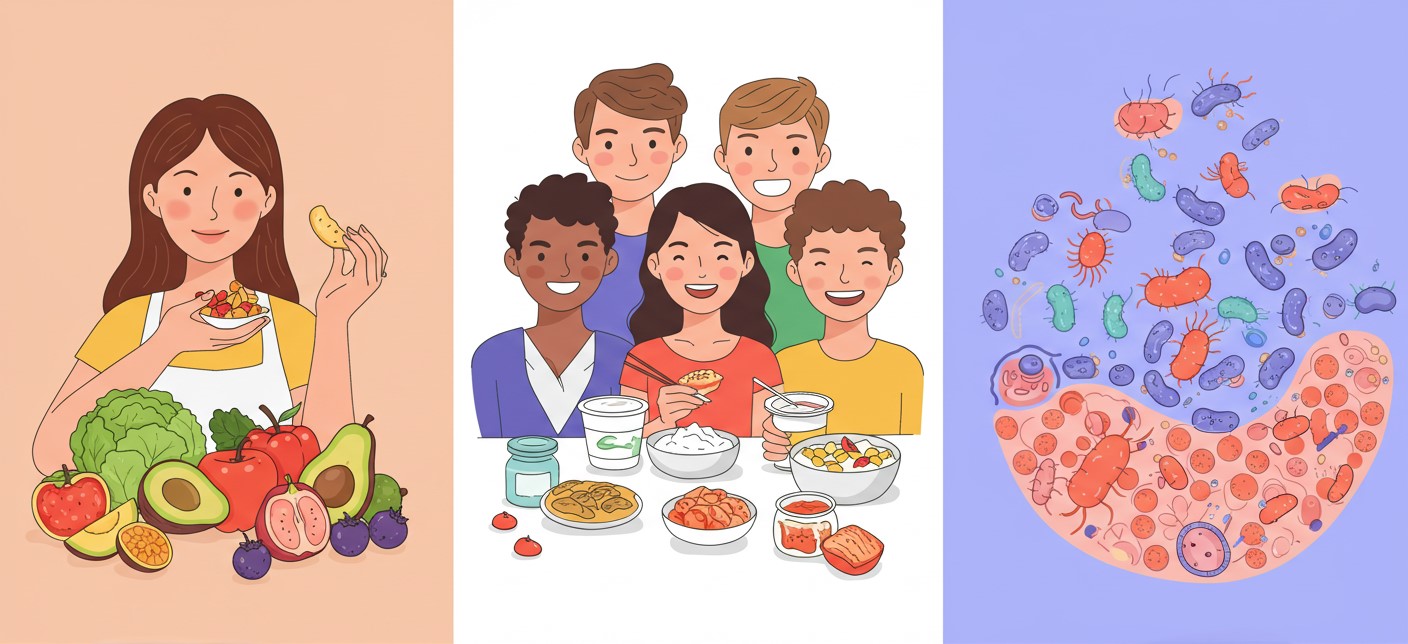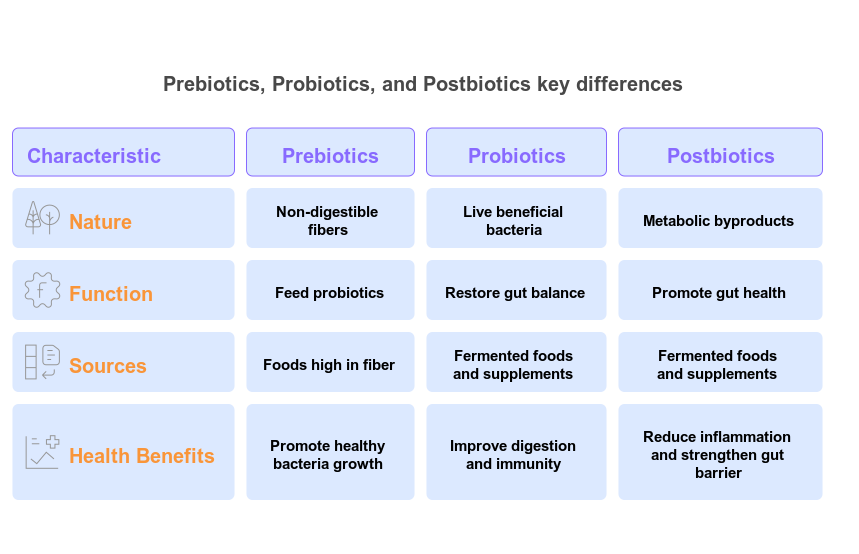Prebiotics are non-digestible dietary fibers that act as a food source for beneficial or good microbiota in our gut. Probiotics are live microorganisms that provide several health benefits when consumed in adequate amounts. While postbiotics are probiotics’ metabolic byproducts produced when live bacteria consume prebiotics.

These three biotics play an essential role in your gut health, which affects your overall well-being. Explore these crucial components that are vital to know when maintaining our gut microbiome.
What are Prebiotics?
Prebiotics are non-digestible dietary fibers that fuel the growth and activities of beneficial gut bacteria, particularly Bifidobacteria and Lactobacilli. Prebiotics were first described in 1995 as a non-digestible ingredient that positively modulates the gut microbiome’s growth and/or activity in the colon.
The International Scientific Association for Probiotics and Prebiotics (ISAPP) defined prebiotics in 2016 as a substrate that is selectively utilized by host microorganisms, providing a health benefit.
Prebiotics resist digestion by slowing down the process in the upper gastrointestinal tract (GIT)and reaching the colon intact, fermenting and feeding beneficial microbes. Inulin, fructooligosaccharides (FOS), galactooligosaccharides (GOS), and lactulose are the most common examples of prebiotics. They are commonly found in plant-based foods. The common sources of prebiotics include:
- Onions
- Jerusalem artichokes
- Asparagus
- Leek
- Garlic
- Bananas
- Chicory
- Cocoa
- Legumes
- Bran
- Whole grains (Barley, oats, wheat, etc.)
Including these sources in your diet can increase the growth of good bacteria essential for digestion, immune function, and overall health.
What are Probiotics?
The concept of probiotics was first discovered by Elie Metchnikoff in the 20th century. This scientist is also known as the father of probiotics. ISAPP defines probiotics as live microorganisms, particularly bacteria, that provide health benefits when consumed appropriately. Probiotics can be found in different fermented foods or supplements. Some common sources include:
- Yogurt
- Kefir
- Sauerkraut
- Kombucha
- Kimchi
- Tempeh
- Miso
- Pickles
- Sourdough bread
- Some types of cheese
These beneficial bacteria help maintain the gut microbiome’s balance, helping digestion and preventing harmful bacteria from proliferating. The probiotics have a broad spectrum of positive effects on your health. Extensive research studies have shown that strain-specific probiotics can reduce antibiotic-related diarrhea, digestive discomfort, bloating, lactose intolerance, mental stress, upper respiratory infections, and more.
What are Postbiotics?
The concept of postbiotics is relatively new compared to probiotics, as many of us don’t know much about it. Postbiotics are healthy metabolic byproducts that result from the metabolic activity of probiotic bacteria. They contain various bioactive compounds, some examples are as follows;
- Short-chain fatty acids (SCFA) such as Butyrate, Acetate
- Bacterial lysates
- Cell wall fragments
- Organic acids like lactic acid
- Bacteriocins
- Peptides
- Vitamins (vitamins B and K)
While still a relatively new concept in the gut health arena, postbiotics are believed to have several benefits, such as:
- Reducing inflammation
- Strengthen the gut barrier integrity
- Supporting immune function
Postbiotics can be found in some fermented foods but are also available as supplements.
Prebiotics vs. Probiotics vs. Postbiotics: Key differences
Let’s look at their key differences to understand how prebiotics, probiotics, and postbiotics work together. Understanding these differences helps you to make optimum choices for your gut health.

How to incorporate 3 Biotics into your diet?
Incorporating prebiotics, probiotics, and postbiotics into your diet can be simple and easy to achieve.
Here are some practical tips:

Prebiotics
- Include more high-fiber fruits and vegetables such as bananas, onions, and asparagus in your meals.
- Substitute refined grains with whole grains like oats, barley, and quinoa.
Probiotics
- Use fermented foods like yogurt, kefir, and sauerkraut at least a few times a week.
- Consider taking probiotic supplements, especially if you’ve recently taken antibiotics.
Postbiotics
- There is no specific declared rich source of postbiotic foods. However, probiotic-rich foods, including fermented foods, can be a good source of postbiotics besides supplements.
Bottom line
Understanding the differences between prebiotics, probiotics, and postbiotics can significantly impact your overall gut health. While prebiotics act as the food source for beneficial bacteria, probiotics are the live bacteria that restore balance in the gut, and postbiotics represent the health-promoting byproducts of these interactions.
Consider incorporating more of these elements into your diet to improve your gut health. A well-balanced intake of all three can lead to better digestive health, improved immunity, and a healthier lifestyle. It is always good to consult with a healthcare professional before making significant changes to your diet or starting supplements. What small change can you make today to support your gut health?
